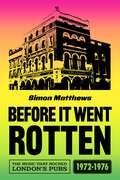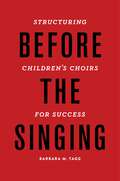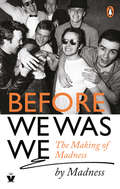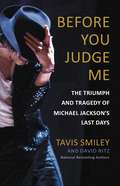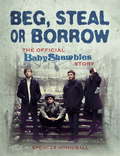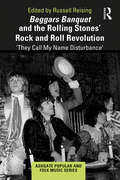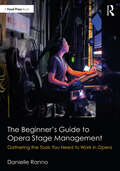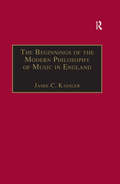- Table View
- List View
Beethoven's Piano Sonatas: A Short Companion
by Charles RosenBeethoven’s piano sonatas form one of the most important collections of works in the whole history of music. Spanning several decades of his life as a composer, the sonatas soon came to be seen as the first body of substantial serious works for piano suited to performance in large concert halls seating hundreds of people.In this comprehensive and authoritative guide, Charles Rosen places the works in context and provides an understanding of the formal principles involved in interpreting and performing this unique repertoire, covering such aspects as sonata form, phrasing, and tempo, as well as the use of pedal and trills. In the second part of his book, he looks at the sonatas individually, from the earliest works of the 1790s through the sonatas of Beethoven’s youthful popularity of the early 1800s, the subsequent years of mastery, the years of stress (1812†“1817), and the last three sonatas of the 1820s.Composed as much for private music-making as public recital, Beethoven’s sonatas have long formed a bridge between the worlds of the salon and the concert hall. For today’s audience, Rosen has written a guide that brings out the gravity, passion, and humor of these works and will enrich the appreciation of a wide range of readers, whether listeners, amateur musicians, or professional pianists.The book includes a CD of Rosen performing extracts from several of the sonatas, illustrating points made in the text.
Beethoven's String Quartet in C-sharp Minor, Op. 131 (Oxford Keynotes)
by Nancy NovemberBeethoven's String Quartet in C-sharp minor Op. 131 (1826) is not only firmly a part of the scholarly canon, the performing canon, and the pedagogical canon, but also makes its presence felt in popular culture. Yet in recent times, the terms in which the C-sharp minor quartet is discussed and presented tend to undermine the multivalent nature of the work. Although it is held up as a masterpiece, Op. 131 has often been understood in monochrome terms as a work portraying tragedy, struggle, and loss. In Beethoven's String Quartet in C-sharp Minor, Op. 13, author Nancy November takes the modern-day listener well beyond these categories of adversity or deficit. The book goes back to early reception documents, including Beethoven's own writings about the work, to help the listener reinterpret and re-hear it. This book reveals the diverse musical ideas present in Op. 131 and places the work in the context of an emerging ideology of silent or 'serious' listening in Beethoven's Europe. It considers how this particular 'late' quartet could speak with special eloquence to a highly select but passionately enthusiastic audience and examines how and why the reception of Op. 131 has changed so profoundly from Beethoven's time to our own.
Beethoven's String Quartet in C-sharp Minor, Op. 131 (Oxford Keynotes)
by Nancy NovemberBeethoven's String Quartet in C-sharp minor Op. 131 (1826) is not only firmly a part of the scholarly canon, the performing canon, and the pedagogical canon, but also makes its presence felt in popular culture. Yet in recent times, the terms in which the C-sharp minor quartet is discussed and presented tend to undermine the multivalent nature of the work. Although it is held up as a masterpiece, Op. 131 has often been understood in monochrome terms as a work portraying tragedy, struggle, and loss. In Beethoven's String Quartet in C-sharp Minor, Op. 13, author Nancy November takes the modern-day listener well beyond these categories of adversity or deficit. The book goes back to early reception documents, including Beethoven's own writings about the work, to help the listener reinterpret and re-hear it. This book reveals the diverse musical ideas present in Op. 131 and places the work in the context of an emerging ideology of silent or 'serious' listening in Beethoven's Europe. It considers how this particular 'late' quartet could speak with special eloquence to a highly select but passionately enthusiastic audience and examines how and why the reception of Op. 131 has changed so profoundly from Beethoven's time to our own.
Beethoven's Symphonies: Nine Approaches to Art and Ideas
by Martin GeckIn the years spanning from 1800 to 1824, Ludwig van Beethoven completed nine symphonies, now considered among the greatest masterpieces of Western music. Yet despite the fact that this time period, located in the wake of the Enlightenment and at the peak of romanticism, was one of rich intellectual exploration and social change, the influence of such threads of thought on Beethoven’s work has until now remained hidden beneath the surface of the notes. Beethoven’s Symphonies presents a fresh look at the great composer’s approach and the ideas that moved him, offering a lively account of the major themes unifying his radically diverse output. Martin Geck opens the book with an enthralling series of cultural, political, and musical motifs that run throughout the symphonies. A leading theme is Beethoven’s intense intellectual and emotional engagement with the figure of Napoleon, an engagement that survived even Beethoven’s disappointment with Napoleon’s decision to be crowned emperor in 1804. Geck also delves into the unique ways in which Beethoven approached beginnings and finales in his symphonies, as well as his innovative use of particular instruments. He then turns to the individual symphonies, tracing elements—a pitch, a chord, a musical theme—that offer a new way of thinking about each work and will make even the most devoted fans of Beethoven admire the symphonies anew. Offering refreshingly inventive readings of the work of one of history’s greatest composers, this book shapes a fascinating picture of the symphonies as a cohesive oeuvre and of Beethoven as a master symphonist.
Beethoven's Symphonies: Nine Approaches to Art and Ideas
by Martin GeckIn the years spanning from 1800 to 1824, Ludwig van Beethoven completed nine symphonies, now considered among the greatest masterpieces of Western music. Yet despite the fact that this time period, located in the wake of the Enlightenment and at the peak of romanticism, was one of rich intellectual exploration and social change, the influence of such threads of thought on Beethoven’s work has until now remained hidden beneath the surface of the notes. Beethoven’s Symphonies presents a fresh look at the great composer’s approach and the ideas that moved him, offering a lively account of the major themes unifying his radically diverse output. Martin Geck opens the book with an enthralling series of cultural, political, and musical motifs that run throughout the symphonies. A leading theme is Beethoven’s intense intellectual and emotional engagement with the figure of Napoleon, an engagement that survived even Beethoven’s disappointment with Napoleon’s decision to be crowned emperor in 1804. Geck also delves into the unique ways in which Beethoven approached beginnings and finales in his symphonies, as well as his innovative use of particular instruments. He then turns to the individual symphonies, tracing elements—a pitch, a chord, a musical theme—that offer a new way of thinking about each work and will make even the most devoted fans of Beethoven admire the symphonies anew. Offering refreshingly inventive readings of the work of one of history’s greatest composers, this book shapes a fascinating picture of the symphonies as a cohesive oeuvre and of Beethoven as a master symphonist.
Beethoven's Symphonies: Nine Approaches to Art and Ideas
by Martin GeckIn the years spanning from 1800 to 1824, Ludwig van Beethoven completed nine symphonies, now considered among the greatest masterpieces of Western music. Yet despite the fact that this time period, located in the wake of the Enlightenment and at the peak of romanticism, was one of rich intellectual exploration and social change, the influence of such threads of thought on Beethoven’s work has until now remained hidden beneath the surface of the notes. Beethoven’s Symphonies presents a fresh look at the great composer’s approach and the ideas that moved him, offering a lively account of the major themes unifying his radically diverse output. Martin Geck opens the book with an enthralling series of cultural, political, and musical motifs that run throughout the symphonies. A leading theme is Beethoven’s intense intellectual and emotional engagement with the figure of Napoleon, an engagement that survived even Beethoven’s disappointment with Napoleon’s decision to be crowned emperor in 1804. Geck also delves into the unique ways in which Beethoven approached beginnings and finales in his symphonies, as well as his innovative use of particular instruments. He then turns to the individual symphonies, tracing elements—a pitch, a chord, a musical theme—that offer a new way of thinking about each work and will make even the most devoted fans of Beethoven admire the symphonies anew. Offering refreshingly inventive readings of the work of one of history’s greatest composers, this book shapes a fascinating picture of the symphonies as a cohesive oeuvre and of Beethoven as a master symphonist.
Beethoven's Symphonies: Nine Approaches to Art and Ideas
by Martin GeckIn the years spanning from 1800 to 1824, Ludwig van Beethoven completed nine symphonies, now considered among the greatest masterpieces of Western music. Yet despite the fact that this time period, located in the wake of the Enlightenment and at the peak of romanticism, was one of rich intellectual exploration and social change, the influence of such threads of thought on Beethoven’s work has until now remained hidden beneath the surface of the notes. Beethoven’s Symphonies presents a fresh look at the great composer’s approach and the ideas that moved him, offering a lively account of the major themes unifying his radically diverse output. Martin Geck opens the book with an enthralling series of cultural, political, and musical motifs that run throughout the symphonies. A leading theme is Beethoven’s intense intellectual and emotional engagement with the figure of Napoleon, an engagement that survived even Beethoven’s disappointment with Napoleon’s decision to be crowned emperor in 1804. Geck also delves into the unique ways in which Beethoven approached beginnings and finales in his symphonies, as well as his innovative use of particular instruments. He then turns to the individual symphonies, tracing elements—a pitch, a chord, a musical theme—that offer a new way of thinking about each work and will make even the most devoted fans of Beethoven admire the symphonies anew. Offering refreshingly inventive readings of the work of one of history’s greatest composers, this book shapes a fascinating picture of the symphonies as a cohesive oeuvre and of Beethoven as a master symphonist.
Beethoven's Symphony No. 9 (Oxford Keynotes)
by Alexander RehdingBeethoven's Ninth Symphony has held musical audiences captive for close to two centuries. Few other musical works hold such a prominent place in the collective imagination; each generation rediscovers the work for itself and makes it its own. Honing in on the significance of the symphony in contemporary culture, this book establishes a dialog between Beethoven's world and ours, marked by the earthshattering events of 1789 and of 1989. In particular, this book outlines what is special about the Ninth in millennial culture. In the present day, music is encoded not only as score but also as digital technology. We encounter Beethoven 9 flashmobs, digitally reconstructed concert halls, globally synchonized performances, and other time-bending procedures. The digital artwork 9 Beet Stretch even presents the Ninth at glacial speed over twenty-four hours, challenges our understanding of the symphony, and encourages us to confront the temporal dimension of Beethoven's music. In the digital age, the Ninth emerges as a musical work that is recomposed and reshaped-and that is robust enough to live up to such treatment-continually adapting to a changing world with changing media.
BEETHOVEN'S SYMPHONY NO. 9 OKS C (Oxford Keynotes)
by Alexander RehdingBeethoven's Ninth Symphony has held musical audiences captive for close to two centuries. Few other musical works hold such a prominent place in the collective imagination; each generation rediscovers the work for itself and makes it its own. Honing in on the significance of the symphony in contemporary culture, this book establishes a dialog between Beethoven's world and ours, marked by the earthshattering events of 1789 and of 1989. In particular, this book outlines what is special about the Ninth in millennial culture. In the present day, music is encoded not only as score but also as digital technology. We encounter Beethoven 9 flashmobs, digitally reconstructed concert halls, globally synchonized performances, and other time-bending procedures. The digital artwork 9 Beet Stretch even presents the Ninth at glacial speed over twenty-four hours, challenges our understanding of the symphony, and encourages us to confront the temporal dimension of Beethoven's music. In the digital age, the Ninth emerges as a musical work that is recomposed and reshaped-and that is robust enough to live up to such treatment-continually adapting to a changing world with changing media.
Before and After Corroboree: The Music Of John Antill
by David SymonsJohn Antill (1904-1986) was one of the foremost composers of Australia's post-colonial period. Although a relatively prolific and much esteemed composer in Australia, Antill's wider reputation is sustained chiefly by his famous ballet Corroboree - a work which was perceived to bring an authentic Australian musical style before both a national and international audience for the first time. Through Sir Eugene Goossens' championship, the work was heard by enthusiastic audiences in Australia, Britain, Europe and the USA, and was, for many years, the best-known work of any Australian-born and resident composer. Indeed it has remained, for both Australian and overseas audiences, an Australian musical icon. David Symons traces Antill's development as a composer from his early, pre-Corroboree works, which display a late Romantic to post-impressionist style, through an analysis of the virile, dissonant, primitivist idiom of his magnum opus, to an examination of his later output of theatrical, orchestral and vocal/choral works. The book provides comprehensive and valuable insight into Antill's musical output, at the same time focussing on more detailed analyses of his major works which have reached public performances and/or recordings. In this way the book not only presents a developmental picture of Antill's works, but also demonstrates why they have made him one of Australia's most prominent musical creators of the post-colonial period.
Before and After Corroboree: The Music Of John Antill
by David SymonsJohn Antill (1904-1986) was one of the foremost composers of Australia's post-colonial period. Although a relatively prolific and much esteemed composer in Australia, Antill's wider reputation is sustained chiefly by his famous ballet Corroboree - a work which was perceived to bring an authentic Australian musical style before both a national and international audience for the first time. Through Sir Eugene Goossens' championship, the work was heard by enthusiastic audiences in Australia, Britain, Europe and the USA, and was, for many years, the best-known work of any Australian-born and resident composer. Indeed it has remained, for both Australian and overseas audiences, an Australian musical icon. David Symons traces Antill's development as a composer from his early, pre-Corroboree works, which display a late Romantic to post-impressionist style, through an analysis of the virile, dissonant, primitivist idiom of his magnum opus, to an examination of his later output of theatrical, orchestral and vocal/choral works. The book provides comprehensive and valuable insight into Antill's musical output, at the same time focussing on more detailed analyses of his major works which have reached public performances and/or recordings. In this way the book not only presents a developmental picture of Antill's works, but also demonstrates why they have made him one of Australia's most prominent musical creators of the post-colonial period.
Before Sound: Re-Composing Material, Time, and Bodies in Music (Musik und Klangkultur #64)
by Tiziano MancaIn Before Sound, composer Tiziano Manca investigates the premises for and consequences of a major change in his compositional practice: this change emphasizes the temporality of sound and, more recently, the relationship between sounding body and musician. It calls into question the traditional conception of composition and its relation to sound material. Accordingly, Manca examines the theoretical and aesthetic reasons for this shift by interweaving aesthetic reflection on his work with historical research on the notion of musical material and the theory of sound production.
Before the Singing: Structuring Children's Choirs for Success
by Dr. Barbara TaggAll children must have an opportunity to share the joy of choral music participation - whether in school, church, or community choirs. What happens before the singing begins, is critical to supporting, sustaining, and nurturing choirs to give every child the opportunity to experience the wonder of choral singing. Based on years of experience conducting and teaching, Barbara Tagg brings a wealth of practical information about ways of organizing choirs. From classroom choirs, to mission statements, boards of directors, commissioning, auditioning, and repertoire, Before the Singing will inspire new ways of thinking about how choirs organize their daily tasks. The collaborative community that surrounds a choir includes conductors, music educators, church choir directors, board members, volunteers, staff, administrators, and university students in music education and nonprofit arts management degree programs. For all these, Tagg offers a wealth of knowledge about creating a positive environment to support artistry, creativity, dedication, and a commitment to striving for excellence.
Before the Singing: Structuring Children's Choirs for Success
by Dr. Barbara TaggAll children must have an opportunity to share the joy of choral music participation - whether in school, church, or community choirs. What happens before the singing begins, is critical to supporting, sustaining, and nurturing choirs to give every child the opportunity to experience the wonder of choral singing. Based on years of experience conducting and teaching, Barbara Tagg brings a wealth of practical information about ways of organizing choirs. From classroom choirs, to mission statements, boards of directors, commissioning, auditioning, and repertoire, Before the Singing will inspire new ways of thinking about how choirs organize their daily tasks. The collaborative community that surrounds a choir includes conductors, music educators, church choir directors, board members, volunteers, staff, administrators, and university students in music education and nonprofit arts management degree programs. For all these, Tagg offers a wealth of knowledge about creating a positive environment to support artistry, creativity, dedication, and a commitment to striving for excellence.
Before We Was We: Madness by Madness
by Lee Thompson Mike Barson Mark Bedford Chris Foreman Graham McPherson Cathal Smyth Dan WoodgateIn Before We Was We, their first official book, Madness tell us how they became them. A story of seven originals, whose collective graft, energy and talent took them from the sweaty depths of the Hope & Anchor's basement to the Top of the Pops studio. In their own words they each look back on their shared adventures. Playing music together, riding freight trains, spraying graffiti and stealing records. Walking in one another's footsteps by day and rising up through the city's exploding pub music scene by night. Before We Was We is irreverent, funny and full of character. Just like them.
Before You Judge Me: The Triumph and Tragedy of Michael Jackson's Last Days
by David Ritz Tavis SmileyA powerful chronicle of the sixteen weeks leading up to King of Pop Michael Jackson's death. Michael Jackson's final months were like the rest of his short and legendary life: filled with deep lows and soaring highs, a constant hunt for privacy, and the pressure and fame that made him socially fragile and almost -- ultimately -- unable to live. With the insight and compassion that he brought to his bestselling story of Martin Luther King, Jr.'s final year, Tavis Smiley provides a glimpse into the superstar's life in this emotional, honest, yet celebratory book. Readers will witness Jackson's campaign to recharge his career -- hiring and firing managers and advisors, turning to and away from family members, fighting depression and drug dependency -- while his one goal remained: to mount the most spectacular series of shows the world had ever seen. Before You Judge Me is a humanizing look at Jackson's last days.
Beg, Steal or Borrow: The Official Baby Shambles Story
by Spencer HonniballCharting the wayward tale of the UK's most notorious group and written with full co-operation of the band this is the ultimate rock and roll story and is destined to become a classic of the genre. From rehab in a Thai monastery to riots at the Astoria, the tabloid exposé of Kate Moss to countless brushes with the law, the book is often funny, sometimes tragic, but always totally compelling. Currently riding high with a critically acclaimed album Sequel to the Prequel under their belt, a successful arena tour of Europe and the UK completed and a host of big festival dates lined up for the summer, Babyshambles are enjoying their most successful year to date.
Beggars Banquet and the Rolling Stones' Rock and Roll Revolution: ‘They Call My Name Disturbance' (Ashgate Popular and Folk Music Series)
by Russell ReisingThe Rolling Stones’ Beggars Banquet is one of the seminal albums in rock history. Arguably it not only marks the advent of the ‘mature’ sound of the Rolling Stones but lays out a new blueprint for an approach to blues-based rock music that would endure for several decades. From its title to the dark themes that pervade some of its songs, Beggars Banquet reflected and helped define a moment marked by violence, decay, and upheaval. It marked a move away from the artistic sonic flourishes of psychedelic rock towards an embrace of foundational streams of American music – blues, country – that had always underpinned the music of the Stones but assumed new primacy in their music after 1968. This move coincided with, and anticipated, the ‘roots’ moves that many leading popular music artists made as the 1960s turned toward a new decade; but unlike many of their peers whose music grew more ‘soft’ and subdued as they embraced traditional styles, the music and attitude of the Stones only grew harder and more menacing, and their status as representatives of the dark underside of the 60s rock counterculture assumed new solidity. For the Rolling Stones, the 1960s ended and the 1970s began with the release of this album in 1968.
Beggars Banquet and the Rolling Stones' Rock and Roll Revolution: ‘They Call My Name Disturbance' (Ashgate Popular and Folk Music Series)
by Russell ReisingThe Rolling Stones’ Beggars Banquet is one of the seminal albums in rock history. Arguably it not only marks the advent of the ‘mature’ sound of the Rolling Stones but lays out a new blueprint for an approach to blues-based rock music that would endure for several decades. From its title to the dark themes that pervade some of its songs, Beggars Banquet reflected and helped define a moment marked by violence, decay, and upheaval. It marked a move away from the artistic sonic flourishes of psychedelic rock towards an embrace of foundational streams of American music – blues, country – that had always underpinned the music of the Stones but assumed new primacy in their music after 1968. This move coincided with, and anticipated, the ‘roots’ moves that many leading popular music artists made as the 1960s turned toward a new decade; but unlike many of their peers whose music grew more ‘soft’ and subdued as they embraced traditional styles, the music and attitude of the Stones only grew harder and more menacing, and their status as representatives of the dark underside of the 60s rock counterculture assumed new solidity. For the Rolling Stones, the 1960s ended and the 1970s began with the release of this album in 1968.
The Beginner’s Guide to Opera Stage Management: Gathering the Tools You Need to Work in Opera
by Danielle RannoThe Beginner’s Guide to Opera Stage Management is the first book to cover theatrical stage management practices specifically for opera productions, providing an invaluable step-by-step guide. Beginning with a brief history of opera and detailing its difference from musical theatre, the book covers stage management best practices through prep, rehearsals, tech, performance, and wrap up. From the moment a manager accepts a contract, right through to archiving paperwork, this essential toolkit covers each step of a stage manager’s journey. Working with a score, reading music, working with singers, conductors, and musicians, basic duties of a stage manager versus an assistant stage manager, and other tasks specific to opera are also included in this comprehensive guide. This book is full of tips and tricks, as well as the good, bad, and ugly stories from opera stage managers, sharing both their experiences and mistakes. This is the perfect how-to book for the professional or emerging stage manager looking to work in opera, or to expand their existing stage management skillset.
The Beginner’s Guide to Opera Stage Management: Gathering the Tools You Need to Work in Opera
by Danielle RannoThe Beginner’s Guide to Opera Stage Management is the first book to cover theatrical stage management practices specifically for opera productions, providing an invaluable step-by-step guide. Beginning with a brief history of opera and detailing its difference from musical theatre, the book covers stage management best practices through prep, rehearsals, tech, performance, and wrap up. From the moment a manager accepts a contract, right through to archiving paperwork, this essential toolkit covers each step of a stage manager’s journey. Working with a score, reading music, working with singers, conductors, and musicians, basic duties of a stage manager versus an assistant stage manager, and other tasks specific to opera are also included in this comprehensive guide. This book is full of tips and tricks, as well as the good, bad, and ugly stories from opera stage managers, sharing both their experiences and mistakes. This is the perfect how-to book for the professional or emerging stage manager looking to work in opera, or to expand their existing stage management skillset.
The Beginnings of the Modern Philosophy of Music in England: Francis North's A Philosophical Essay of Musick (1677) with comments of Isaac Newton, Roger North and in the Philosophical Transactions
by Jamie C. KasslerIn 1677 a slim quarto volume was published anonymously as A Philosophical Essay of Musick. Written by Francis North (1637-85), chief justice of the Common Pleas, the Essay is in the form of a legal case argued from an hypothesis. Utilising the pendulum as his hypothesis, North provided a rationale from mechanics for the emerging new musical practice we now call 'tonality'. He also made auditory resonance the connecting link between acoustical events in the external world and the musical meanings the mind makes on the basis of sensory perception. Thus began the modern philosophy of music that culminated with the work of Hermann von Helmholtz. As a step towards understanding this tradition, Jamie C. Kassler examines the 1677 Essay in its historical context. After assessing three seventeenth-century criticisms of it and outlining how one critic developed some implications in the Essay, she summarises the basic principles that have guided the modern philosophy of music from its beginnings in the 1677 Essay. The book includes an annotated edition of the Essay as well as the comments of the three critics.
The Beginnings of the Modern Philosophy of Music in England: Francis North's A Philosophical Essay of Musick (1677) with comments of Isaac Newton, Roger North and in the Philosophical Transactions
by Jamie C. KasslerIn 1677 a slim quarto volume was published anonymously as A Philosophical Essay of Musick. Written by Francis North (1637-85), chief justice of the Common Pleas, the Essay is in the form of a legal case argued from an hypothesis. Utilising the pendulum as his hypothesis, North provided a rationale from mechanics for the emerging new musical practice we now call 'tonality'. He also made auditory resonance the connecting link between acoustical events in the external world and the musical meanings the mind makes on the basis of sensory perception. Thus began the modern philosophy of music that culminated with the work of Hermann von Helmholtz. As a step towards understanding this tradition, Jamie C. Kassler examines the 1677 Essay in its historical context. After assessing three seventeenth-century criticisms of it and outlining how one critic developed some implications in the Essay, she summarises the basic principles that have guided the modern philosophy of music from its beginnings in the 1677 Essay. The book includes an annotated edition of the Essay as well as the comments of the three critics.
Behind_Bars_Updated: The Definitive Guide To Music Notation (Faber Edition Ser.)
by Elaine GouldBehind Bars is the indispensable reference book for composers, arrangers, teachers and students of composition, editors, and music processors. In the most thorough and painstakingly researched book to be published since the 1980s, specialist music editor Elaine Gould provides a comprehensive grounding in notational principles. Behind Bars covers everything from basic rules, conventions and themes to complex instrumental techniques, empowering the reader to prepare music with total clarity and precision. With the advent of computer technology, it has never been more important for musicians to have ready access to principles of best practice in this dynamic field, and this book will support the endeavours of software users and devotees of hand-copying alike. The author's understanding of, and passion for, her subject has resulted in a book that is not only practical but also compellingly readable.





